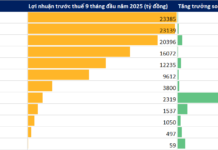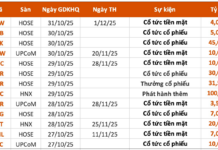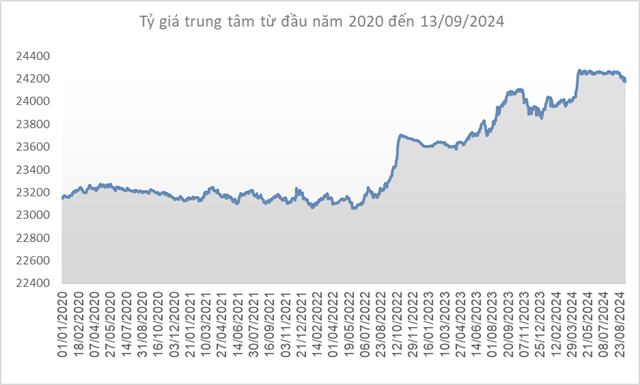Regarding the low credit growth in Ho Chi Minh City, NLD had a conversation with Mr. Nguyen Duc Len, Deputy Director of the State Bank of Vietnam’s Ho Chi Minh City Branch, to gain further insights on the matter.
Interviewer: As the country’s economic locomotive, Ho Chi Minh City’s credit growth for the first eight months was only 4.5% according to the city’s Statistics Bureau, while the national growth reached 6.63%. What, in your opinion, caused this discrepancy, Mr. Len?

Mr. Nguyen Duc Len, Deputy Director of SBV’s Ho Chi Minh City Branch
Mr. Nguyen Duc Len: The 4.5% credit growth figure for Ho Chi Minh City, as reported by the city’s Statistics Bureau, is an estimated number. We do not yet have the actual data. Technically speaking, if the national credit growth stands at 6.63%, then the actual credit growth figure for Ho Chi Minh City will likely be higher than the estimated 4.5%. This adjustment is due to the city’s credit balance, which accounts for a significant proportion (approximately 26%-27%) of the country’s total credit balance. Moreover, the city’s credit growth plays a crucial role in both the national credit growth and the realization of the banking sector’s orientation.
From a macroeconomic perspective, there is a symbiotic relationship between credit growth and economic growth. Credit facilitates the capital needs of production and business activities, thereby fostering economic growth. Conversely, economic growth stimulates credit growth. In this regard, credit growth depends on multiple factors. To identify the causes and influencing factors, a comprehensive analysis and evaluation are necessary, encompassing monetary and credit policies, banking sector lending activities and solutions, as well as the effectiveness of production and business operations, and the capital demands of businesses and the economy as a whole.

Commercial banks have implemented numerous solutions to boost credit growth. Photo: Lam Giang
In the current context, with low-interest rate policies and a credit mechanism focused on supporting businesses, along with the effective implementation of various business support and problem-solving solutions by the banking sector, credit growth largely depends on the capital demands of the economy and businesses’ capacity to absorb capital.
The low credit growth indicates that businesses’ and the economy’s capacity to absorb capital has not improved significantly. Are there any particular reasons for this?
– Indeed, the capital demands and absorption capacity of businesses and the economy play a pivotal role in promoting effective credit expansion and growth. In reality, with Ho Chi Minh City’s current credit scale of approximately VND 3.6 quadrillion, a 1% growth in a month would equate to VND 36 trillion, which is substantial. Absorbing this amount of capital requires a corresponding economic growth rate, considering the relationship between credit and GRDP.
From this perspective, positive shifts in total demand, with a focus on key growth drivers such as exports, investment, and consumption, have been observed, particularly in export activities, consumption, and tourism services. Decisive solutions regarding public investment disbursement will act as catalysts for overall growth and create a favorable socio-economic environment to stimulate credit growth in the upcoming period.
Continuing Supportive Measures
What measures has the SBV’s Ho Chi Minh City Branch implemented to boost credit growth and facilitate connections between banks and businesses seeking capital?
– The SBV’s 15% credit growth target aims to support and promote economic growth as planned, while also serving as a monetary and credit solution for 2024. From a local perspective, Ho Chi Minh City’s banking sector focuses on effectively implementing monetary and credit policies in the area. This includes support measures for businesses, addressing their capital needs, and aligning with interest rate and credit policies. Examples include reducing lending rates for businesses, restructuring debts to maintain the original debt group, and providing loans to five key sectors: export, agriculture and rural areas, small and medium-sized enterprises, supporting industries, and high-tech enterprises. We also facilitate the disbursement of preferential credit packages and successfully carry out the bank connection program, which includes loan agreements, policy dialogues, and direct problem-solving collaborations with departments, sectors, and business associations.
By doing so, we not only fulfill the task of supporting and addressing challenges faced by businesses, creating favorable conditions for their access to capital and banking services, but we also boost credit and economic growth. This will remain a key solution that the city’s banking sector will continue to implement through the end of the year.
The imperative to enhance credit growth must be accompanied by maintaining credit quality. Given the recent rapid increase in non-performing loans, what has the SBV’s Ho Chi Minh City Branch instructed the credit institutions to do?
– To accomplish this task, from a management perspective, Ho Chi Minh City’s banking sector has focused on effectively implementing monetary, credit, and banking solutions in accordance with Directive 01 of the SBV. We have executed our state management responsibilities in the fields of money and credit on the premises, maintaining stability in the monetary market and banking activities. Additionally, we have promoted administrative reform and enhanced service quality, coupled with technological innovation, improved operational efficiency, and created a conducive investment and business environment. These efforts not only channel capital into production and business activities but also help control bad debts.
Segmentation of Industries for Lending
Mr. Pham Nhu Anh, CEO of Military Bank (MB), shared that as of late August 2024, MB’s credit growth reached 10.44% (over VND 679 trillion). MB expects to achieve an additional growth of approximately VND 14 trillion and is well-prepared to realize a 20%-25% growth plan while maintaining strict control over credit quality.
To stimulate credit in the remaining months of the year, MB has segmented industries in its lending activities to allocate growth room and manage business operations. The bank continues to prioritize retail lending, production and business lending, and lending to the processing and manufacturing industries.





































